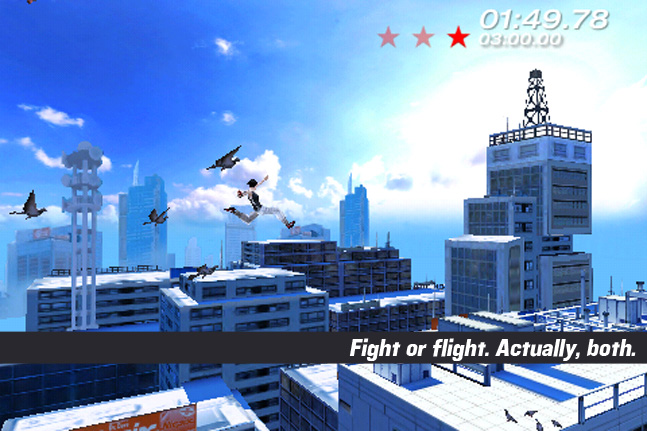 Yesterday, EA came to NYC and held a press event for us game journalists in The Big Apple, and we all got to play around with their big spring time releases. Unfortunately, virtually everything touched I can’t talk about until their embargo dates expire, which is a few weeks from now. At least there’s one title that I’m able to discuss, and it’s the iPhone remake of Mirror’s Edge.
Yesterday, EA came to NYC and held a press event for us game journalists in The Big Apple, and we all got to play around with their big spring time releases. Unfortunately, virtually everything touched I can’t talk about until their embargo dates expire, which is a few weeks from now. At least there’s one title that I’m able to discuss, and it’s the iPhone remake of Mirror’s Edge.
If you’re familiar with the Xbox 360 and PS3 version from a few years back, then expect the same game, albeit in a much smaller package. The biggest change, obviously, is the shift from a first person, 3D perspective to a side scrolling, 2D experience. So, does it play like the very excellent 2D version that’s available on the web? Not really. The graphics are still three-dimensional polygons, and even though it’s nice and all, one simply cannot beat beautifully rendered two-dimensional line-art. Plus it also makes more sense on a smaller screen.
In most respects, it’s actually closer to Canabalt, especially when it comes to control; you swipe to the right to get Faith going, who then constantly moves forward, much like you do in that other game. So no having to constantly push an onscreen button and obscuring the action, thank goodness. The key to maintaining your speed and momentum is by deftly dealing with obstacles; you swipe in assorted directions to jump, slide, or roll from a large leap. Environmental hazards, much like in the original game, is color coded red so they’re hard to miss.
I actually asked the demo person how much of an impact Canabalt played in its development, and only got a nervous laugh. To be honest, can’t blame the person’s somewhat tepid response; people are already making harsh comparisons between the two, and they’re truly not the same game. Whereas Canabalt is a completely “twitch” experience, Mirror’s Edge is far more forgiving, and designed with more hand’s on control in mind. Which sounds great in theory, but the execution… If you miss a jump or hit a wall in Canabalt, you’re dead, end of game. But in Mirror’s Edge, if you come to a dead halt or miss a jump (that’s not above a bottomless pit, granted), there’s usually a second chance, by swiping and running the other way, quickly changing direction, and hope you have enough momentum this time to overcome the challenge a second time. Sounds great on paper, but the control was not super tight or response, in that way that most iPhone games are, so it’s not exactly EA’s fault, and one can certainly get used to it like in every other iPhone game of its nature.
But my biggest beef was during combat; I was expecting bad guys to be dealt with in QTE fashion, which usually is a cheap way out on consoles with it comes to delivering complex, action-oriented set-pieces, but again makes total sense on smaller, more limited platform like the iPhone. But instead, you just run into them and hope to swipe the screen at the right time to take them out. if you miss, same as before, but instead of having to pass a stationary wall, there’s some dude that’s got his gun aimed and you (plus shooting), so getting back into gear, and not being able to do so thanks to the aforementioned technical constraints, is a bit aggravating.
But again, it’s all stuff that one can get used to. No further details were given in terms of the games length, but if it does indeed follow the structure of the console version, I’m expecting most of the levels and narrative to tag along. As for multiplayer modes and speed runs, all of those details have yet to be revealed, but hopefully soon. Expect a full review when the time comes.
Comments
Hands On: Mirror’s Edge For The iPhone